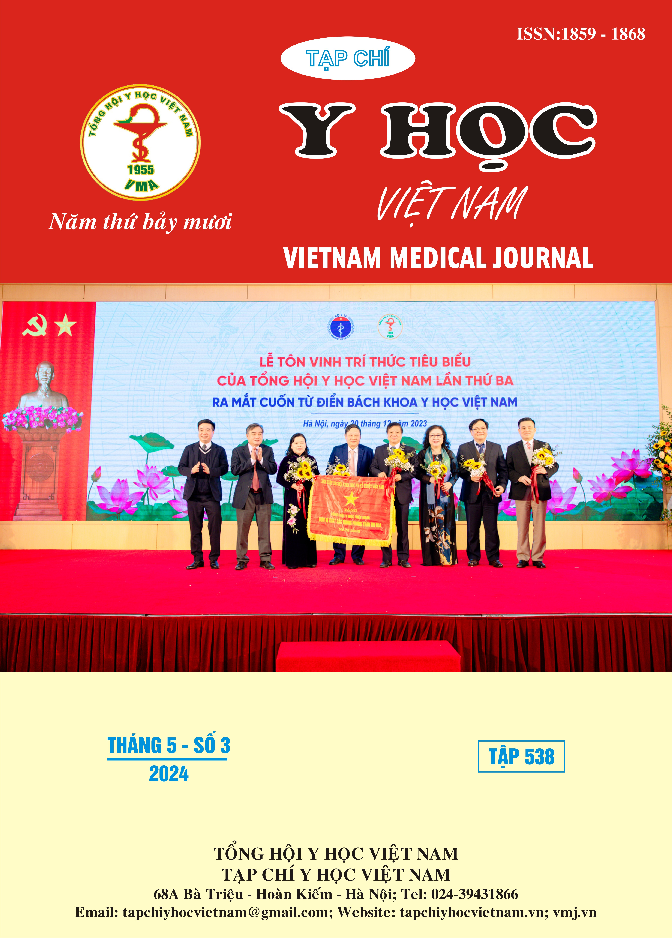VALUE OF 1.5-TESLA MAGNETIC RESONANCE IMAGING IN ASSESSMENT OF LIGAMENTOUS AND MENISCAL INJURIES IN COMPARISON WITH DIAGNOSIS IN KNEE ARTHROSCOPY
Main Article Content
Abstract
Objectives: To evaluate the value of 1.5-tesla magnetic resonance imaging in assessment of ligamentous and meniscal injuries in comparison with diagnosis in knee arthroscopy. Subjects: 98 patients with knee injuries were examined and had MRI scans to determine intra-articular knee injuries and underwent knee arthroscopy at Duc Giang General Hospital. Time period of the study was from January 2018 to January 2020. Research indicators: gender, age, injury location, time from injuries happened to when MRI scans were taken, ligamentous and meniscal injuries on MRI and in knee arthroscopy: Anterior cruciate ligaments, posterior cruciate ligaments, collateral ligaments. Results: From 98 patients, there were indicators: Age ranging from 15 - 63 years old. Under 20 years old accounted for 6.1%, from 20 to 40 was 73.5%, over 40 was 20.4%. Time from injuries happened to when MRI scans were taken: Under 2 weeks accounted for 29.6%, from 2 weeks to 3 months formed 39.8%, over 3 months constituted 30.6%. Locations of injuries: right knee joints accounted for 52%, 48% with left knee joint injuries, no case with both knee joints injured. The most common injury on MRI we encountered was ACL tear with a rate of 94.9% meanwhile the PCL tear was less common with a rate of 5.1%. Both cruciate ligaments torn accounted for 3%. Medial and lateral meniscus tears had rates of 45.9% and 25.5%, respectively. Anterior displacement of the tibia accounted for a relatively high rate of 42.9%. The rate of bone marrow edema in the tibial plateau was 35.7% and the rate of bone marrow edema in the femoral condyles was 23,5%. The posterior horn of the lateral meniscus was pushed back in 2% of cases. Medial collateral ligament injuries formed 2% and laterall collateral ligament injuries accounted for 1%. Diagnostic value of ACL injuries on MRI compared to knee arthroscopy: Sensitivity was 98.9%, specificity was 100%, positive predictive value was 100%, negative predictive value was 80%. Diagnostic value of ACL injuries on MRI compared to knee arthroscopy: Sensitivity was 100% (4/4), specificity was 98.9%, positive predictive value was 80%, negative predictive value was 100% (93/93). Diagnostic value of medial meniscus injuries on MRI compared to knee arthroscopy: Sensitivity was 100%, specificity was 88.3%, positive predictive value was 84.4%, negative predictive value was 100%. Diagnostic value of lateral meniscus injuries on MRI compared to knee arthroscopy: Sensitivity was 73.5%, specificity was 100%. Positive predictive value was 100%, negative predictive value was 87.6%. Conclusions: In comparison to the definitive diagnosis in knee arthroscopy, the assessment of ligamentous and meniscal injury grades on MRI has high accuracy. Therefore, MRI is a method that plays a particularly important role in diagnosing and evaluating the nature and extent of traumatic knee joint injuries.
Article Details
Keywords
Magnetic resonance imaging of the knee, knee injury, knee injury on MRI, knee arthroscopy
References
2. Kun Li, Jun Du, Li-Xin Huang et al. The diagnostic accuracy of magnetic resonance imaging for anterior cruciate ligament injury in comparison to arthroscopy: a meta-analysis., Scientific Reports. 2017;
3. Jie C. Nguyen, MS Arthur A. De Smet and MD Ben K. Graf MR Imaging–based Diagnosis and Classification of Meniscal Tears, RadioGraphics. 2014; 34: 981–999.
4. David Rubin and Robin Smithuis. Knee – non meniscal Pathology. Publicationdate August 2, Radiology assistant. 2005.
5. Vande Berg BC, Malghem J, Poilvache P. et al. Meniscal Tears with Fragments Displaced in Notch and Recesses of Knee: MR Imaging with Arthroscopic Comparison. Radiology.2005; 234(3), 842–850.
6. Lê Huỳnh Anh Vũ và Nguyễn Duy Huề. Phân tích đặc điểm hình ảnh và giá trị chẩn đoán của cộng hưởng từ trong tổn thương dây chằng chéo khớp gối do chấn thương. Y Học Thực Hành. 2006; 56, (4) - 2008.
7. Phạm Hồng Đức, Trần Công Hoan và Nguyễn Tuấn Anh. Giá trị chẩn đoán của cộng hưởng từ trong rách sụn chêm khớp gối do chấn thương, Y Học Thực Hành (866) – số 4. 20138.
8. Hà Đức Cường. Nhận xét bước đầu qua 55 trường hợp phẫu thuật nội soi khớp gối tại Bệnh viện Bưu điện Hà Nội, Y học thực hành. (728) - số 7. 2010.
9. Justin W. Kung, Corrie M. Yablon and Ronald L. Eisenberg Bone Marrow Signal Alteration in the Extremities., American Journal of Roentgenology. 196, W492-W510. 2011.


